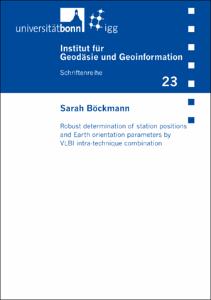Robust determination of station positions and Earth orientation parameters by VLBI intra-technique combination

Robust determination of station positions and Earth orientation parameters by VLBI intra-technique combination

| dc.contributor.author | Böckmann, Sarah | |
| dc.date.accessioned | 2020-01-14T15:31:14Z | |
| dc.date.available | 2020-01-14T15:31:14Z | |
| dc.date.issued | 2011 | |
| dc.identifier.uri | https://hdl.handle.net/20.500.11811/1414 | |
| dc.description.abstract | In this thesis, it is shown that combining contributions of different VLBI analysis centers, a so called intratechnique combination, improves the robustness and stability of the final VLBI results. For this purpose, a refined combination method has been developed which is in many theoretical and practical aspects superior to combination approaches currently used for comparable geodetic combination tasks. For example, datum-free normal equation systems are used as input, which ensure that the contributions are not deformed by any constraints at all, and the same underlying terrestrial reference frame can be applied during the combination process. Furthermore, a statistically rigorous variance component estimation approach for the relative weighting of the contributions is used. The combination process implies detailed comparisons and analyses of the individual ACs’ contributions. From these, as one of the outcomes of this thesis, several systematic differences between the individual contributions were detected and eliminated. The adherence to standards was considerably improved. The combination process itself reduces the “analyst’s noise” and damps the impact of outliers. Validations with independent results of other space-geodetic techniques confirm a benefit of up to 15% more accurate results than from individual solutions. Another aspect of this thesis is the general problem of any intra-technique combination, the correlations between the individual contributions. So far, the contributions of different ACs are always treated as independent data sets, although they have been derived from virtually the same set of original observations. It is shown that correlations between the individual ACs’ contributions can be determined and rigorously taken in account during the combination process if the combination is performed directly on the level of the observation equations, instead on the level of normal equation systems. The main effect of considering these correlations is that the formal errors of the estimated combined parameters are considerably more realistic, but the parameters as such remain unchanged within their formal errors. | en |
| dc.description.abstract | Robuste Schätzung von Stationskoordinaten und Erdorientierungsparametern durch die VLBI intra-technik Kombination In der vorliegenden Arbeit wird gezeigt, dass eine Kombination von Beiträgen verschiedener VLBI Analysezentren, eine so genannte Intra-Technik Kombination, die Robustheit und Stabilität der endgültigen VLBI Ergebnisse verbessert. Dazu wird eine verfeinerte Kombinationsmethode entwickelt, die in vielen theoretischen und praktischen Aspekten besser ist bisher existierende Realisierungen. Zum Beispiel werden als Eingangsdaten datumsfreie Normalgleichungen genutzt, durch die gewährleitest wird, dass keiner der Beiträge vor der Kombination durch Bedingungen deformiert ist. Darüber hinaus bieten sie den Vorteil, dass derselbe zugrunde liegende terrestrische Referenzrahmen verwendet werden kann. Ferner erfolgt die relative Gewichtung der einzelnen Beiträge über eine statistisch strenge Varianz-Komponenten Schätzung. Der Kombinationsprozess impliziert detaillierte Vergleiche und Analysen der einzelnen Beiträge. Dadurch werden systematische Unterschiede zwischen den Einzelbeiträgen aufgedeckt und beseitigt sowie erhebliche Verbesserungen in der Einhaltung von Standards erzielt. Durch den Kombinationsprozess selbst wird das sog. “Analysten-Rauschen” reduziert. Validierungen mit unabhängigen Ergebnissen anderer Weltraumverfahren können einen Genauigkeitsgewinn von bis zu 15% gegenüber den Einzellösungen bestätigen. Darüber hinaus wird in dieser Arbeit das allgemeine Problem einer jeden Intra-Technik Kombination untersucht, das in der Abhängigkeit der einzelnen Beiträge voneinander besteht. Bisher wurden diese als unabhängig voneinander betrachtet, obwohl sie nahezu den gleichen Satz an originären Beobachtungsdaten verwenden. Es wird gezeigt, dass Korrelationen zwischen den einzelnen Beiträgen bestimmt und streng im Kombinationsprozess berücksichtigt werden können, wenn die Kombination direkt auf der Ebene der Beobachtungsgleichungen anstatt auf der bisher verwendeten Normalgleichungsebene durchgeführt wird. Die Berücksichtigung dieser Korrelationen führt in erster Linie zu realistischeren Standardabweichungen der geschätzten kombinierten Parameter, die Parameter als solche bleiben innerhalb ihrer formalen Fehler unverändert. | de |
| dc.format.extent | 78 | |
| dc.language.iso | eng | |
| dc.relation.ispartofseries | Schriftenreihe / Institut für Geodäsie und Geoinformation ; 23 | |
| dc.rights | In Copyright | |
| dc.rights.uri | http://rightsstatements.org/vocab/InC/1.0/ | |
| dc.subject | VLBI | |
| dc.subject | Very Long Baseline Interferometry | |
| dc.subject | Stationskoordinaten | |
| dc.subject | Erdorientierungsparameter | |
| dc.subject | Kombination | |
| dc.subject | station positions | |
| dc.subject | Earth orientation parameters | |
| dc.subject | combination | |
| dc.subject.ddc | 526.1 Geodäsie | |
| dc.title | Robust determination of station positions and Earth orientation parameters by VLBI intra-technique combination | |
| dc.type | Dissertation oder Habilitation | |
| dc.publisher.name | Rheinische Friedrich-Wilhelms-Universität Bonn, Landwirtschaftliche Fakultät, IGG - Institut für Geodäsie und Geoinformation | |
| dc.publisher.location | Bonn | |
| dc.rights.accessRights | openAccess | |
| dc.relation.pissn | 1864-1113 | |
| dc.relation.urn | https://nbn-resolving.org/urn:nbn:de:hbz:5N-23152 | |
| ulbbn.pubtype | Zweitveröffentlichung |




